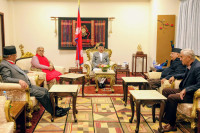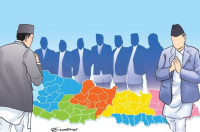Opinion
Let people decide
Direct democracy would have been more suitable for Nepal-copy.jpg&w=900&height=601)
Subhanu Khanal
Nepal acquired its sense of national identity after Prithvi Narayan Shah united varied tiny principalities into one political identity in 1768. In this regard, Nepal can be called the oldest nation-state in South Asia. In 1768, the US was still struggling to free itself from the yoke of British colonialism and India existed as a splintered subcontinent similarly plagued and plundered by British imperialism. However, it would not be a red herring to say that it was united administratively and regions with seats of power like Kathmandu, Lalitpur and Bhaktapur were able to capture more of the administrative benefits.
Power games
The kind of political system that was imposed on the people, first absolute monarchy and later the Rana oligarchy, ensured that power remained the prerogative of a few and the majority remained disenfranchised. Indian independence from the British Raj effectively decimated the power of the Ranas, and democracy knocked the rusty door of the oligarchy, and in 1951, finally let itself in.
Although the system of representative democracy that Nepal adopted then was better than the previous autocratic system, direct democracy would have been more suitable. What representative democracy did was allow the privileged literate and educated elite to net the benefits from the new system, and gave them the time, resources and power to keep the system rigged in their favour. Power was transferred not from the previously totalitarian state to the people, but to a group that claimed to represent the people.
Nevertheless, the fragile representative democracy was crushed again in 1960, and the Panchayat system concentrated power in the Shah monarchy. The Panchayat system was overthrown and the multiparty parliamentary system reinstated in 1990. But how well did the representatives represent the values, priorities and desires of the people who voted for them? The answer to this question came in a brutal form with the outbreak of the Maoist insurgency which culminated in the Comprehensive Peace Accord of 2006. A Constituent Assembly was formed to write a new constitution but it could not deliver. Another election cycle produced another Constituent Assembly which, after producing the statute, transformed into the country’s legislative body. This series of experiments did not bring political stability to Nepal. The main culprit has been the indirect form of representative democracy that the parties embraced, knowing that a more evolved and direct form of direct democracy, that empowers every citizen equally, would decimate their power forever.
The workable option
The new constitution too embraces representative democracy, and the result has been a continuation of the number game among a few parliamentarians that changes governments every few months. This has led to inconsistency in national policy formulation and implementation. While the new constitution contains a provision to prevent such abrupt changes in government by disallowing a vote of no confidence against any government for two years, this is more a palliative and less a panacea to the deeply entrenched political practice of abrupt changes in government. An enduring solution to this endless problem would be allowing Nepali citizens to participate in direct democracy as opposed to indirect representative democracy.
The beauty of direct democracy is that Nepal would be able to circumvent policy inconsistency that dogs all three organs of the state as every issue would be directly subject to a national referendum, and hence, every Nepali citizen would have an equal voice in the decision making process. This is in sharp contrast to a system where a few individuals run for election with a strong but often mendacious claim to be representing their constituencies. In this system, each individual would represent herself and no one would be burdened with the task of having to represent more than her own thoughts and issues. Power too would hence be vested back into each individual. Since every major issue—new laws and implementation of major energy and infrastructure projects—would be subject to a referendum. Political leadership would be vested in one individual who would be directly elected by all Nepali citizens. This would shape a definite path to a stable policy formulation environment and consistency over policy would prevail.
Not impossible
Those sceptical of a direct democratic system would argue that the burgeoning population of the country, along with the high administrative costs associated with it, prevents Nepal from practicing a direct democratic model. However, how practical is the current system of a parliament with 601 members, in which one parliamentarian has a claim to represent 44,925 people? One person cannot be a point where the inherently diverse opinions and voices of 44,925 people can be reconciled. Moreover, the individual’s vested interest can always overshadow the voices of the many whom the individual claims to represent.
It goes without saying that the costs of running a direct democracy would put a heavy burden on the nation’s exchequer. However, a better outcome for the exchequer from it is that it will not be abused as wantonly as has been done by the people’s representatives. Thus, in the long run, the funds there will be parlayed into much needed capital investment for the country in the form of public roads, schools and community hospitals. The biggest contribution of pure democracy to Nepal would perhaps be the elimination of party politics, which is an ineluctable by-product of representative democracy that has so fettered Nepal’s progress.
Khanal is a consultant to the Investment Board




 9.12°C Kathmandu
9.12°C Kathmandu










